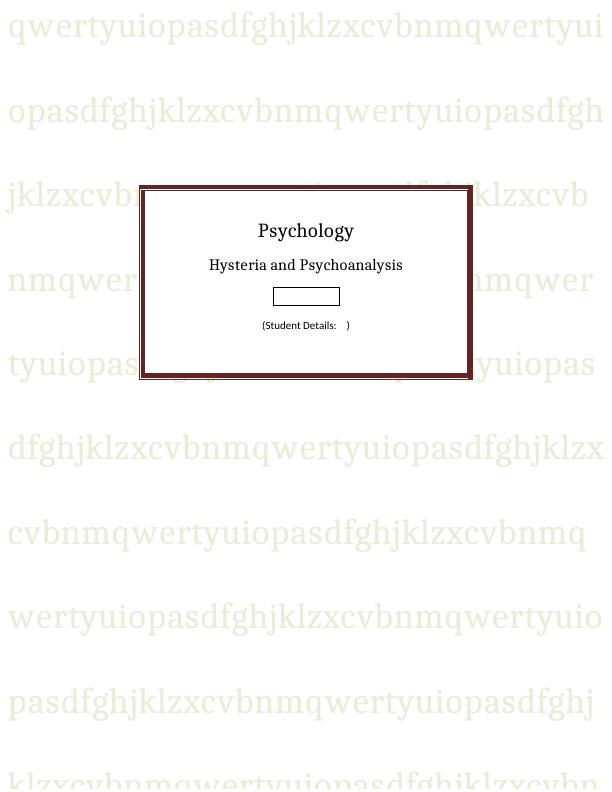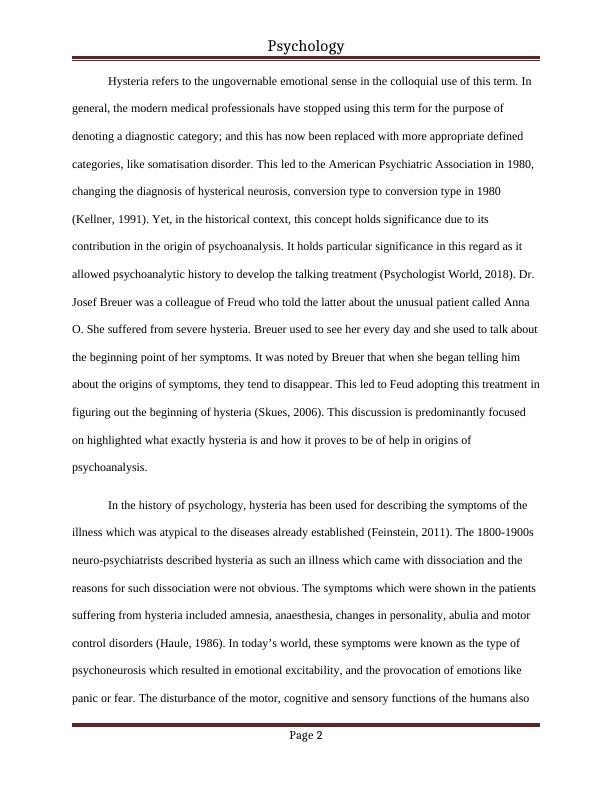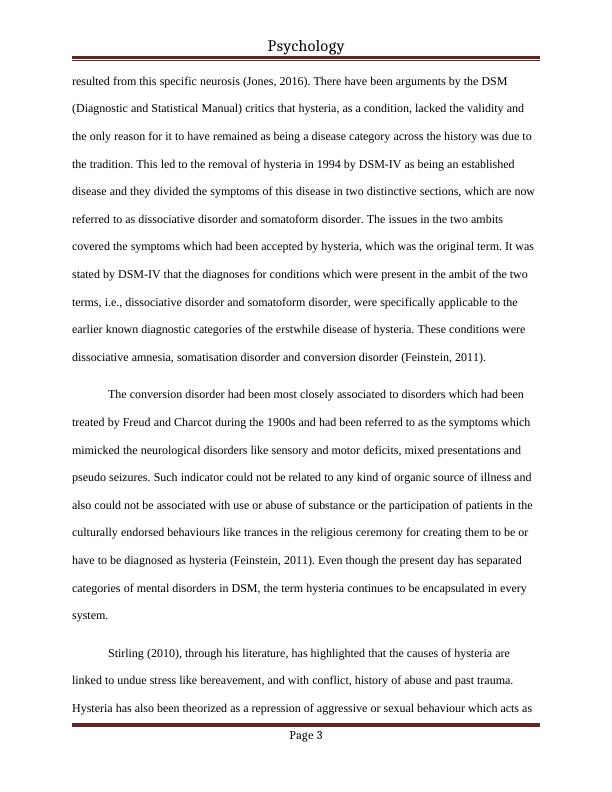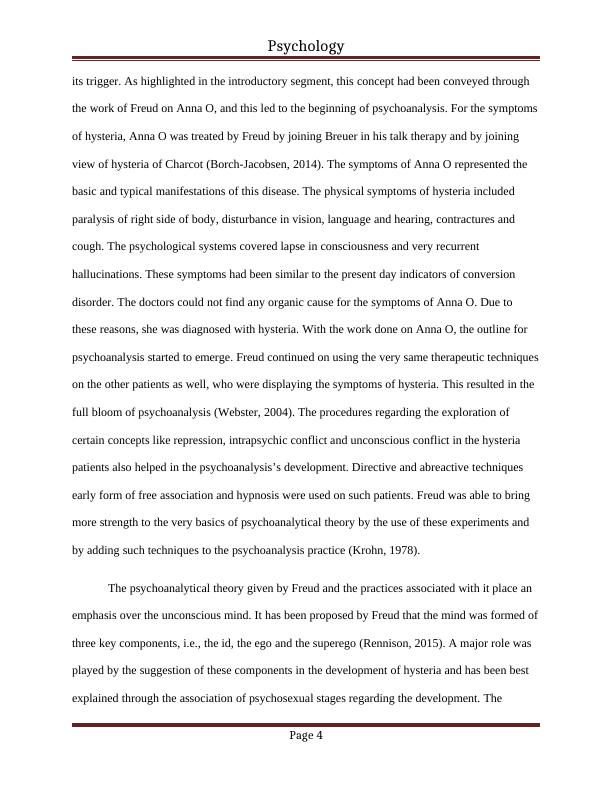Ask a question from expert
Hysteria and Psychoanalysis - Assignment
11 Pages3271 Words181 Views
Added on 2020-05-28
Hysteria and Psychoanalysis - Assignment
Added on 2020-05-28
BookmarkShareRelated Documents
qwertyuiopasdfghjklzxcvbnmqwertyuiopasdfghjklzxcvbnmqwertyuiopasdfghjklzxcvbnmqwertyuiopasdfghjklzxcvbnmqwertyuiopasdfghjklzxcvbnmqwertyuiopasdfghjklzxcvbnmqwertyuiopasdfghjklzxcvbnmqwertyuiopasdfghjklzxcvbnmqwertyuiopasdfghjklzxcvbnmqwertyuiopasdfghjklzxcvbnmqwertyuiopasdfghjklzxcvbnmqwertyuiopasdfghjklzxcvbnmqwertyuiopasdfghjklzxcvbnPsychologyHysteria and Psychoanalysis(Student Details: )

PsychologyHysteria refers to the ungovernable emotional sense in the colloquial use of this term. In general, the modern medical professionals have stopped using this term for the purpose of denoting a diagnostic category; and this has now been replaced with more appropriate defined categories, like somatisation disorder. This led to the American Psychiatric Association in 1980, changing the diagnosis of hysterical neurosis, conversion type to conversion type in 1980 (Kellner, 1991). Yet, in the historical context, this concept holds significance due to its contribution in the origin of psychoanalysis. It holds particular significance in this regard as it allowed psychoanalytic history to develop the talking treatment (Psychologist World, 2018). Dr. Josef Breuer was a colleague of Freud who told the latter about the unusual patient called Anna O. She suffered from severe hysteria. Breuer used to see her every day and she used to talk aboutthe beginning point of her symptoms. It was noted by Breuer that when she began telling him about the origins of symptoms, they tend to disappear. This led to Feud adopting this treatment infiguring out the beginning of hysteria (Skues, 2006). This discussion is predominantly focused on highlighted what exactly hysteria is and how it proves to be of help in origins of psychoanalysis. In the history of psychology, hysteria has been used for describing the symptoms of the illness which was atypical to the diseases already established (Feinstein, 2011). The 1800-1900s neuro-psychiatrists described hysteria as such an illness which came with dissociation and the reasons for such dissociation were not obvious. The symptoms which were shown in the patients suffering from hysteria included amnesia, anaesthesia, changes in personality, abulia and motor control disorders (Haule, 1986). In today’s world, these symptoms were known as the type of psychoneurosis which resulted in emotional excitability, and the provocation of emotions like panic or fear. The disturbance of the motor, cognitive and sensory functions of the humans also Page 2

Psychologyresulted from this specific neurosis (Jones, 2016). There have been arguments by the DSM (Diagnostic and Statistical Manual) critics that hysteria, as a condition, lacked the validity and the only reason for it to have remained as being a disease category across the history was due to the tradition. This led to the removal of hysteria in 1994 by DSM-IV as being an established disease and they divided the symptoms of this disease in two distinctive sections, which are now referred to as dissociative disorder and somatoform disorder. The issues in the two ambits covered the symptoms which had been accepted by hysteria, which was the original term. It was stated by DSM-IV that the diagnoses for conditions which were present in the ambit of the two terms, i.e., dissociative disorder and somatoform disorder, were specifically applicable to the earlier known diagnostic categories of the erstwhile disease of hysteria. These conditions were dissociative amnesia, somatisation disorder and conversion disorder (Feinstein, 2011). The conversion disorder had been most closely associated to disorders which had been treated by Freud and Charcot during the 1900s and had been referred to as the symptoms which mimicked the neurological disorders like sensory and motor deficits, mixed presentations and pseudo seizures. Such indicator could not be related to any kind of organic source of illness and also could not be associated with use or abuse of substance or the participation of patients in the culturally endorsed behaviours like trances in the religious ceremony for creating them to be or have to be diagnosed as hysteria (Feinstein, 2011). Even though the present day has separated categories of mental disorders in DSM, the term hysteria continues to be encapsulated in every system. Stirling (2010), through his literature, has highlighted that the causes of hysteria are linked to undue stress like bereavement, and with conflict, history of abuse and past trauma. Hysteria has also been theorized as a repression of aggressive or sexual behaviour which acts as Page 3

Psychologyits trigger. As highlighted in the introductory segment, this concept had been conveyed through the work of Freud on Anna O, and this led to the beginning of psychoanalysis. For the symptomsof hysteria, Anna O was treated by Freud by joining Breuer in his talk therapy and by joining view of hysteria of Charcot (Borch-Jacobsen, 2014). The symptoms of Anna O represented the basic and typical manifestations of this disease. The physical symptoms of hysteria included paralysis of right side of body, disturbance in vision, language and hearing, contractures and cough. The psychological systems covered lapse in consciousness and very recurrent hallucinations. These symptoms had been similar to the present day indicators of conversion disorder. The doctors could not find any organic cause for the symptoms of Anna O. Due to these reasons, she was diagnosed with hysteria. With the work done on Anna O, the outline for psychoanalysis started to emerge. Freud continued on using the very same therapeutic techniqueson the other patients as well, who were displaying the symptoms of hysteria. This resulted in the full bloom of psychoanalysis (Webster, 2004). The procedures regarding the exploration of certain concepts like repression, intrapsychic conflict and unconscious conflict in the hysteria patients also helped in the psychoanalysis’s development. Directive and abreactive techniques early form of free association and hypnosis were used on such patients. Freud was able to bring more strength to the very basics of psychoanalytical theory by the use of these experiments and by adding such techniques to the psychoanalysis practice (Krohn, 1978). The psychoanalytical theory given by Freud and the practices associated with it place an emphasis over the unconscious mind. It has been proposed by Freud that the mind was formed ofthree key components, i.e., the id, the ego and the superego (Rennison, 2015). A major role was played by the suggestion of these components in the development of hysteria and has been best explained through the association of psychosexual stages regarding the development. The Page 4

End of preview
Want to access all the pages? Upload your documents or become a member.
Related Documents
Date Hysteria and Psychoanalytic Theorylg...
|15
|4644
|71